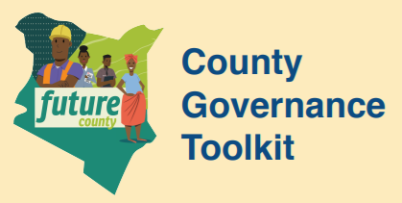Performance Management is the combination of steps and measures a government adopts to ensure that decisions are implemented, and targets are met. This is to ensure that the government delivers the services we expect as a society.
Some of the measures that counties are expected to adopt include:
- Performance Management Plan and performance reports (CGA, 2012, Art. 47)
- Performance Contracts (signed by CECs, COs and Directors)
- Staff appraisal (PAS)
- Service charters
- Incentive schemes
- Social Accountability Mechanisms, etc.
A simplified description of the annual flow of performance management begins with the approval of the budget – which assigns resources to each program and sub-program – and departmental work plans.
In addition to informing procurement plans and cash flow projections, the work plan identifies the annual targets for each key performance indicator (KPI). Department leaders – CECs, COs, and Directors – then sign performance contracts informed by these annual targets.
Services are delivered by implementing the budget and periodic reports and additional quality control mechanisms allow for the review and appraisal of the performance of each department and – ideally – of each service delivery point.
Multiple bodies inside a county government are involved in performance management and this can create friction and overlaps. Different counties are organized differently, and there is no single optimal way to approach performance management. What matters the most is the adherence to a few guiding principles and clear separation of roles.
Guiding Principles:
- Service Delivery is more than just “Projects” – it includes many services funded under the recurrent budget such as salaries of nurses and doctors, garbage collection, etc. Key performance indicators (KPIs) must also reflect the outcomes of these critical services.
- Service Delivery happens at field level through health units, extension teams, vocational training schools, etc. Therefore targets, monitoring and the realization of results flows from the bottom, upwards
- Implementation responsibility rests with county departments – for example, the Chief Officer in charge of water supply is the Accounting Officer (the person legally accountable) for all spending on water supply systems and maintenance.
- Monitoring and reporting on spending and progress is critical to make informed decisions on performance. A single source of information for all stakeholders (quarterly reports) is ideal.
- Internal controls and incentives are also critical
Key roles and institutional arrangements:

- Service Delivery Unit (SDU): Though names and functions vary across counties, the main function of these units should be to provide quality control on the effectiveness and efficiency of county departments in performing their service delivery functions. The scope should not be limited to large or flagship projects. The roles of SDUs may include conducting internal performance audits and managing citizens’ feedback mechanisms to ensure the county is responsive to constituents. They have no direct implementation or resource management mandate and are usually housed under the Office of the Governor.
- Performance Contracts Secretariat: The Secretariat is in charge of the issuance and periodic review of performance contracts (PCs). It is usually housed under the office of the County Secretary, as is the human resource management function and responsibility for the Personnel Appraisal System (PAS). Note: cascading targets and connecting PCs and PAS has proven a challenge
- County Public Service Board: Responsible for recruitment and public service standards, they have a say on the County Personnel Appraisal system.
County Performance Management Framework
Adopted in 2016 by the Council of Governors, the County Performance Management Framework (CPMF, see diagram), links everyday spending and service delivery to longer-term goals identified in key government documents (Vision 2030, CIDP, etc.).
Resources:
County Performance Management Framework. Council of Governors, 2016
Performance Contracting Guidelines, 2018
County Integrated Monitoring and Evaluation System (CIMES) guidelines. Monitoring and Evaluation Dept, National Treasury and COG, 2019
Sector performance standards, The Presidency, Ministry of Devolution and Planning, 2015


